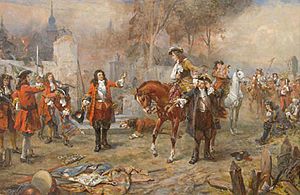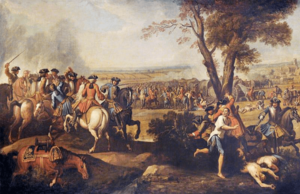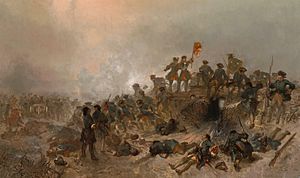Danish Auxiliary Corps in Anglo-Dutch service 1701–1714 facts for kids
Denmark had a very large army in 1700. It was so big that the country couldn't afford it anymore. The King of Denmark decided to lend about half of his army to other countries. These countries were fighting in a big war called the War of the Spanish Succession.
In 1701, Denmark made a deal with the Dutch Republic and Kingdom of England. They sent 12,000 Danish soldiers to help the Allied powers in a region called Flanders. These Danish soldiers fought in major battles like Blenheim, Ramillies, Oudenarde, and Malplaquet. They faced many dangers and suffered heavy losses. The soldiers finally returned home to Denmark in 1713 and 1714.
Contents
Why Denmark Sent Soldiers Abroad
Denmark had just finished a war with Sweden in 1700. This war was part of the Great Nordic War. Sweden had landed troops on Zealand, which forced Denmark to make peace. The peace of Travendal meant Denmark had to give back Holstein-Gottorp to its duke, who was an ally of Sweden. Denmark also had to leave the alliance against Sweden.
Denmark had built a very large army for this war. But now, with peace, this army was very expensive to keep. It was a big problem for Denmark's money. The King didn't want to make the army smaller. He hoped to fight Sweden again later to get back lands lost in the treaty of Roskilde in 1658.
So, the King decided to lend more than half of his 35,000 soldiers to other countries. Many of these soldiers were hired from Germany. By helping the Allied powers in the War of the Spanish Succession, Denmark hoped to gain their friendship. This friendship could be useful in future wars with Sweden or Holstein-Gottorp.
The Agreement for Danish Soldiers
In 1701, Denmark agreed to send 12,000 soldiers to the Allied powers. This was part of a defense agreement with the Dutch Republic and Kingdom of England.
- 3,000 soldiers would be horsemen (cavalry).
- 1,000 would be dragoons (soldiers who could fight on horseback or on foot).
- 8,000 would be foot soldiers (infantry).
In return, Denmark received a large sum of money. They got 540,000 rixdollars right away. They also received 300,000 rixdollars every year as long as the war continued. Any old money Denmark owed to these powers was also canceled.
The Danish soldiers would be paid and supplied according to Dutch rules. Danish paymasters would handle their wages. At the end of each year's fighting season, the Danish group would get money to replace soldiers they had lost. If a whole company or regiment was destroyed, its leader would get enough money to rebuild it. This agreement was set to last for ten years.
In 1703, two more regiments were added to the Danish group. These were a dragoon regiment and a foot regiment. They were officially raised in the name of the small dukes of Württemberg-Oels. But Denmark actually raised them, and they were part of the Danish forces. After the war, these soldiers joined the Danish army.
The Battle of Blenheim
The Danish soldiers were led by Duke Carl Rudolf of Württemberg. In October 1701, the foot soldiers sailed from Glückstadt and landed in Nordholland. The horsemen rode across the Elbe river. They marched through Hanover and Münster to Friesland and Brabant.
For most of the war, the Danish forces were part of the Allied armies in Flanders. In 1702, they helped capture the Liege citadel. They also fought in the battle of Beverloo, which ended in a draw. In 1703, the Württemberg-Oels regiments joined them.
In 1704, Marlborough's army marched to southern Germany. But Duke Carl refused to move his Danish soldiers until they were paid. Once the payment issue was fixed in March, the Danish forces stayed in southern Brabant until late July. Then, they were ordered to join the main army after a long march of 700 kilometers.
The horsemen rode straight to Nördlingen. The foot soldiers took a longer path and joined Eugene of Savoy's army in Heidelberg. The region of Bavaria was badly damaged because its leader had joined Louis XIV against the Emperor. In August, Marlborough's and Eugene's armies joined together. They won a huge victory at the battle of Blenheim. About 2,300 Danish soldiers were killed or wounded in this battle. The total Allied losses were 13,000.
The Battle of Ramillies
In late 1704, the Danish forces were again under Marlborough's command. They helped capture the towns of Trarbach and Saarburg. They spent the winter between the Moselle and the Rhine rivers. The fighting in 1705 was difficult because the Allied commanders argued a lot. No major attacks happened that year.
In spring 1706, Duke Carl again refused to move his soldiers. He waited until the Dutch Republic kept its promises. By late May, the Danish forces finally joined Marlborough's army. The Danish horsemen were very important in the victory at the battle of Ramillies. They attacked the French and Bavarian side, losing 600 men and 800 horses.
After Ramillies, the Danish forces helped capture several towns, including Antwerp, Ostend, Menen, Ath, Dendermonde, and Oudenaarde. In 1706, they lost a total of 2,200 soldiers and 1,300 horses. However, new recruits joined their ranks during the winter. In 1707, Marlborough's army mostly defended its positions. This was because half of his troops had been sent to Spain and Germany.
Oudenarde and Malplaquet Battles
In 1708, the French army invaded Flanders with a huge force. They even threatened to land in England. Eugene of Savoy arrived with a large Imperial army to help Marlborough. In the battle of Oudenarde, the Danish horsemen, led by Jørgen Rantzau, played a key role. They captured three French groups of soldiers.
Overall, the fighting in 1708 caused 3,500 losses for the Danish forces. But their numbers were quickly filled by new recruits. Many of these new soldiers were defectors and deserters from the French side.
In 1709, the Danish forces stayed in their winter camps until June. They were waiting for one million guilders that the Dutch Republic owed them. The 1709 campaign began with the capture of Tournai. This was followed by the battle of Malplaquet. Here, the Danish forces suffered 1,300 losses. This victory allowed the Allies to capture Mons before the end of the year.
The war in the next two years mostly involved surrounding and capturing towns. In 1712, peace talks began between France and the United Kingdom. The British government no longer needed the Danish regiments. However, the Dutch Republic immediately took them over. In 1713, the Danish units that had been paid by England returned to Denmark. The rest of the soldiers returned in 1714.
Order of Battle
The Danish Auxiliary Corps that served England and the Dutch Republic included:
- 16 squadrons of horsemen (cavalry)
- 9 battalions of foot soldiers (infantry)
Each squadron of horsemen had three companies. Each battalion of foot soldiers had seven companies. The Württemberg-Oels dragoons and foot soldiers were added in 1703.
| Original Regiments | Auxiliary Corps Units | Paid by |
|---|---|---|
| Horsemen | ||
| Livregiment til Hest | 2 squadrons | Dutch Republic |
| Ahlefeldts Kyrasserregiment (Würtembergske Kyrasserregiment 1705) | 2 squadrons | England |
| Holstenske Rytterregiment | 2 squadrons | England |
| 2. Sjællandske Rytterregiment | 2 squadrons | Dutch Republic |
| 2. Jyske Rytterregiment | 2 squadrons | England |
| 3. Jyske Rytterregiment | 2 squadrons | England |
| 4. Jyske Rytterregiment | 2 squadrons | Dutch Republic |
| 5. Jyske Rytterregiment | 2 squadrons | Dutch Republic |
| Foot Soldiers | ||
| Garden | 1 battalion | Dutch Republic |
| Prins Carls Regiment | 2 battalions | England |
| Prins Georges Regiment | 2 battalions | England |
| Sjællandske Regiment | 2 battalions | Dutch Republic |
| Fynske Regiment | 1 battalion | Dutch Republic |
| Oldenburgske Regiment | 1 battalion | England |
| Reinforcements in 1703 | ||
| Württemberg-Oels Dragoner | 2 squadrons | England, Dutch Republic |
| Hertugen af Württemberg-Oels Regiment | 1 battalion | England, Dutch Republic |
| Sources: | ||
See also





